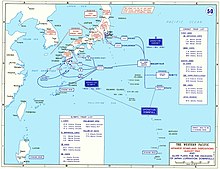
Back عملية السقوط Arabic سوقوط عملیاتی AZB Операция „Даунфол“ Bulgarian Operació Downfall Catalan Operace Downfall Czech Operation Downfall Danish Operation Downfall German Operaco Downfall Esperanto Operación Downfall Spanish عملیات سقوط Persian
| Operation Downfall | |
|---|---|
| Part of the Pacific War | |
 | |
| Location | |
| Planned | Before August 1945 |
| Planned by | |
| Commanded by | Douglas MacArthur |
| Objective | Defeat the Empire of Japan |
| Executed by | See Orders of battle |
| Outcome | Cancelled after the unconditional surrender of Japan on August 15, 1945 |
| Casualties | See estimated casualties |
Operation Downfall was the proposed Allied plan for the invasion of the Japanese home islands near the end of World War II. The planned operation was canceled when Japan surrendered following the atomic bombings of Hiroshima and Nagasaki, the Soviet declaration of war, and the invasion of Manchuria.[1] The operation had two parts: Operation Olympic and Operation Coronet. Set to begin in November 1945, Operation Olympic was intended to capture the southern third of the southernmost main Japanese island, Kyūshū, with the recently captured island of Okinawa to be used as a staging area. In early 1946 would come Operation Coronet, the planned invasion of the Kantō Plain, near Tokyo, on the main Japanese island of Honshu. Airbases on Kyūshū captured in Operation Olympic would allow land-based air support for Operation Coronet. If Downfall had taken place, it would have been the largest amphibious operation in history, surpassing D-Day.[2]
Japan's geography made this invasion plan obvious to the Japanese as well; they were able to accurately predict the Allied invasion plans and thus adjust their defensive plan, Operation Ketsugō (ja), accordingly. The Japanese planned an all-out defense of Kyūshū, with little left in reserve for any subsequent defense operations. Casualty predictions varied but were extremely high, from the low hundreds of thousands to over a million on the Allied side and into the millions for the Japanese.[3]